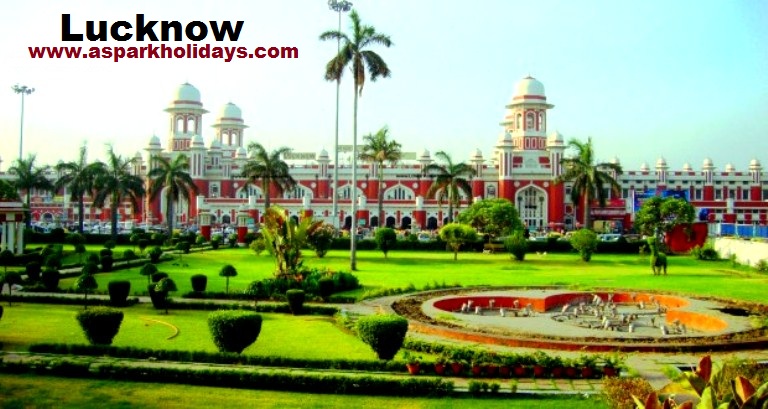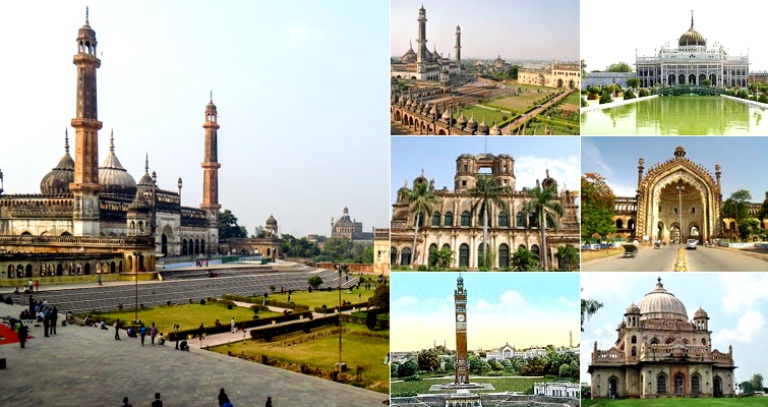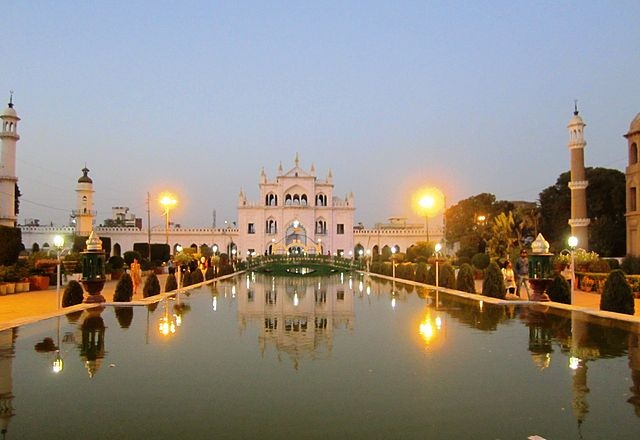
History of Lucknow
The Lucknow witnessed the rise and fall of many dynasties. When the Mughals conquered North India in the 16th century it was absorbed into their empire and rapidly developed under Akbar patronage. In the 18th century, Nawab Sadat Ali Khan founded the Oudh (Awadh) dynasty. The builder of Lucknow was Nawab Asif-ud-Daula who shifted his capital here from Faizabad in 1775 and shaped it into a city of gardens and great buildings like the Great Imambara. He also emptied the regal coffers with his ambitious building and personal extravagance. The rulers of Oudh were great connoisseurs of music and poetry. It remained a center of political and cultural activities. In the mid 1850, under Lord Dalhousie, the British annexed a number of Indian states. The Lord Dalhousie considered British rule so superior to Indian that the more territory directly administered by the British the better it would be for the Indian people. He therefore evolved a policy of lapse whereby the states of Indian princes without direct heirs could be taken over on the ruler death. Chronic mismanagement was also the main cause for takeover. The great Muslim state of Oudh was annexed for this second reason. The Oudh dyansty also falls as the Nawab Wajid Ali Shah was so engrossed in his game of chess that he remained unheeding to his tasks even when British soldiers occupied his capital. Whatever the justification, there was considerable resentment against the British because it was generally regarded as a breach of faith. A strong British presence was established in the city and it became a key administrative and military centre. In 1857, when the mutiny broke, Sir Henry Lawrence gathered the British community into the Residency which was turned into a fortress. The ensureing siege lasted for 87 days. When the relieving force under sir Colin Campbell finally broke through, the once splendid Residency was a blackened ruins, its walls pockmarked and gaping with cannon ball holes. Today it is a mute witness to a desperate struggle.
Lucknow Cuisine, Cuisine of Lucknow- Lucknow is also a gourmet city. Lucknavi Parathas (unleavened bread) with 10 layers are soft and crisp. Variety of Kababs, Dampukhta, Seenkh Kabab, Rumali Roti, Kulcha Nahari, Biryani, Sheermal etc. are some of the famous dishes of Lucknow. There are also various restaurants and eating joints in Lucknow, where you can have truly delicious Lakhnawi cuisine. The coffee shops, pizza outlets and fast food joins are also available as well.
Shopping in Lucknow- Lucknow is the home of the fascinating Chikankari or exquisite shadow work embroidery on fine mulin cloth, perfumes (with a base of sandalwood oil, agar, saffron and other herbs), zari (silver and gold thread embroidery), clay toys, velvet slippers, block-printed fabrics and glazed pottery. The Chikankari of Lucknow is known all over the world. The craftsmanship of Lucknow artist is unparallel in Zardozi, Kaamdani, and Mukesh works. Sarees, Lehngas, Lanchas and Kurtas can be bought from here. The main shopping areas in the city are Hazratogaj, Aminabad, Janpath, Chowk, Nakkhas, Sadar and Kapoorthala.
Festivals of Lucknow- Some of the major Hindu and Muslim festivals are celebrated in Lucknow. There are also several festivals celebrated distinctively in Lucknow. The day after Diwali is celebrated with a great fair and national kite flying competition at the Patang Park. In the month of February, the UP Government organizes the Lucknow festival. Song, drama, dance, processions, boating, ekka races are the main features of the ten day festival with special emphasis on the performance of Indian classical music. Moharram is another festival which is celebrated in Lucknow. This is really not a festival but a period of mourning when huge tazias (replicas of tombs of the son-inlsaw and grandsons of the Prophet) are taken out in procession by Shia Muslims amidst beating of breasts. The pageantry of the Nawabi days is re-enacted. Fire-walking takes place on one of the nights.
Tourist Attractions of Lucknow
There are various majestic monuments and buildings in Lucknow, which speak of its glorious past. Bara Imambara, Hussainabad Imambara, Rumi Darwaza, Lakshman Tila, Picture Gallery, Dilkusha Kothi, Chowk, The Residency, Dr. Bhim Rao Ambedkar Memorial and State Museum are the main tourist attractions in Lucknow.
Bara Imambara- The main attraction of Lucknow is the Bara (Big) Imambara, also known as Asafi Imambara. It was built by Nawab Asif-ud-Daula in 1784 and one of the architectural wonders of Lucknow. It was constructed to provide employment during a famine. The absence of beams and pillaris in the huge main hall is an architectural wonder. Its central hall is said to be the largest vaulted chamber in the world. Except for the galleries in the interior, there is no wood work in the entire structure. It has a charming accurate labyrinths supporting the roof of the edifice, known as Bhul-Bhulaiya. Here, various visitors are totally lost and so they are strictly advised to visit only with a guide. One could wander through narrow zigzag galleries for hours without finding the way out. Within the compound of the Imambara is the grand Asafi Masjid.
Rumi Darwaza- The Rumi Darwaza is the massive gateway of the Bara Imambara. This colossal and or nated gateway is presumed to be a facsimile of one of the gateways of Constantinople in Turkey.
Chowk- Chowk is the main bazaar in the old city. Here flourish the saris, gold and silver brocades, clay figures, pottery and folk embroidery. It was the haunt of the feudal aristocracy in the old days and is still the place for good bargains. Old Nawabi houses are also situated in the area which are still inhabited by patrician families. It is here that the old culture and graciousb Nawabi manners still persist, that reminds of the 18th century culture of Lucknow.
Hussainabad Imambara- Hussainabad Imambara, also known as the Chotta (small) Imambara houses the tombs of Muhammad Ali Shah and his mother. This Imambara was built by Muhammad Ali Shah in a florid Saracenic style with a dome, turrets and minarets. This Imambara has numerous domes and minarets. The hall contained a silver throne and is very picturesque when illuminated. The 67 meter high clock tower opposite the Imambara was built between 1860 and 1887.
Dilkusha Kothi- Dilkusha Kothi is set amidst lush green lawns and was built in the Gothic style. The Kothi and its adjoining magnificent garden were created by Nawab Saadat Ali Khan. It is almost an exact replica of an English country house called Seeaton Delavel, built in 1721.
Hussainabad Imambara, Lucknow
- Dr. Bhim Rao Ambedkar Mermorial, Lucknow
- Dr. Bhim Rao Ambedkar Memorial
Dr. Bhim Rao Ambedkar Memorial is the newly added attraction in Lucknow. This memorial is spread over 53 acres of land in Gomti Nagar, and dedicated in the memory of Dr. B.R. Ambedkar. In the heart of this sprawling complex, stands a 112 feet high memorial resembling a Stupa, with a 16 feet high bronze statue of Dr. Ambedkar. Numerous figures of life-size elephant, lush gardens with a 20 feet. wide canal surrounds the memorial.
Lakshman Tila- Lakshman Tila is situated on the right banks of the river Gomti and was the original site of Lucknow in the 15th century. This place is now crowned by the mosque of Aurangzeb. A family from Bijnor also built a fort here at the end of the 13th century. It then passed through a number of hands, including the Sharqi kings of Jaunpur and Sher Shah of Delhi.
The Residency- The Residency was designed by the Saadat Ali for the British Resident during 1780-1800. Here many dramatic events during the first war of independence in 1857 took place. This building is now in ruins and still bears the scars of destruction. The ground floor houses a small museum in which there is a model that shows the layout of the whole area in 1857. The gardens around the Residency are beautifully kept and are peaceful. Daily light and sound show is held here which recounts the history of Awadh through the character of the river, Gomti. This sound show is held against the romantic backdrop of the Residency. The skillful use of light and shade, with an evocative narration, brings alive the history of Lucknow. The picture gallery is situated nearby which contains the portraits of Nawabs of Oudh.
State Museum- The State Museum is the oldest museum in Uttar Pradesh and one of the richest in India. This museum has a fascinating collection of artifacts from the first to eleventh centuries, stone sculptures from Mathura, busts and friezes from Allahabad and Garhwa, Hindu and Buddhists and Jain works and an Egyptian mummy. The relics of the British Raj are kept in the backyard of the museum where you can also see a range of marble sculptures of the former British citizens, removed at the time of independence when they were replaced by the statues deemed to be more appropriate.
Excursions
Sravasti- Sravasti was an important city at the time of Buddha. Buddha came to Sravasti to preach and it was also the place where he performed some miracles to convince the non-believers about the truth of his religion. He preached at the monastery of Jetavana. After his death, the monastery enjoyed royal patronage, particularly from Ashoka and it remained active until the 11th century. The remains of the city and monastery are around the current villages of Maheth and Seth.
Gorakhpur- Gorakhpur is a thriving town on the Indo-Nepal border and provides easy access to some of the most important places connected with the life of Lord Buddha.
How to get here
By Air:- Lucknow is directly connected by Indian Airlines flights with Delhi, Patna, Kolkata, Gorakhpur, Mumbai, Kanpur and Varanasi with regular flights. The Amousi airport is about 14 km from the city centre.
By Rail:- Lucknow is on the trunk line and has direct rail connections with Agra, Ahmedabad, Amritsar, Bomaby, Cochin, Delhi, Gorakhpur, Jammu, Puri, Varanasi, etc. The most convenient connection from Delhi is Shatabdi Express which is air-conditioned.
By Road:- Lucknow is well connected by road with all major cities of the country like Kanpur, Ayodhya, Allahabad, Varanasi, Khajurhao, Agra and Delhi.
Need Aspark Help?
For Tour Packages, Vehicle Rental and Customer Care Support.
+91 9999 31 7846
booking@asparkholidays.comWhy Travel with Us?

Excellent Support
Our Team Available 24x7 for Customer support
Best Price & Savings
We Offer the Most Competitive Prices.


